Denver, Colorado Blood Testing Facilities
 Represents a LabCorp blood testing facility
Represents a LabCorp blood testing facility Represents a Quest Diagnostics blood testing facility
Represents a Quest Diagnostics blood testing facility

Nearby Labcorp Blood Testing facilities:
- Labcorp Center Distance: 3 m, 4500 E 9Th Ave Ste 430, Denver, Denver County, CO, 80220
- Labcorp Center Distance: 5 m, 3555 Lutheran Pkwy Ste 190, Wheat Ridge, Jefferson County, CO, 80033
- Labcorp Center Distance: 6 m, 1805 Kipling St 111, Lakewood, Jefferson County, CO, 80215
- Labcorp Center Distance: 9 m, 1550 S Potomac Ste 325, Aurora, Arapahoe County, CO, 80012
- Labcorp Center Distance: 10 m, 8200 E Belleview Ave Ste 234C, Greenwood Village, Arapahoe County, CO, 80111
- Labcorp Center Distance: 11 m, 6169 S Balsam Way Ste 312, Littleton, Jefferson County, CO, 80123
- Labcorp Center Distance: 12 m, 206 W County Line Rd Ste 150, Highlands Ranch, Douglas County, CO, 80129
- Labcorp Center Distance: 13 m, 9141 S Broadway, Highlands Ranch, Douglas County, CO, 80129
- Labcorp Center Distance: 16 m, 10103 Ridgegate Pkwy Ste 123, Lone Tree, Douglas County, CO, 80124
- Labcorp Center Distance: 18 m, 24250 E Smoky Hill Rd, Aurora, Arapahoe County, CO, 80016
- Labcorp Center Distance: 20 m, 19641 East Parker Square Dr I, Parker, Douglas County, CO, 80134
- Labcorp Center Distance: 24 m, 14 E Allen St, Castle Rock, Douglas County, CO, 80108
- Labcorp Center Distance: 53 m, 2126 Milestone Dr Ste 121, Fort Collins, Larimer County, CO, 80524
- Labcorp Center Distance: 56 m, 8540 Scarborough Dr Ste 170, Colorado Springs, El Paso County, CO, 80920
- Labcorp Center Distance: 58 m, 5664 N Union Blvd, Colorado Springs, El Paso County, CO, 80918
- Labcorp Center Distance: 64 m, 3225 International Cir Ste 200, Colorado Springs, El Paso County, CO, 80910
- Labcorp Center Distance: 99 m, 729 East Spaulding Ave, Pueblo West, Pueblo County, CO, 81007
Nearby Quest Blood Testing facilities:
- Quest Center Distance: 3 m, 695 S Broadway, Denver, Denver County, CO, 80209-4003
- Quest Center Distance: 5 m, 7353 Federal Blvd, Westminster, Adams County, CO, 80030-4903
- Quest Center Distance: 6 m, 201 E Jefferson Ave, Englewood, Arapahoe County, CO, 80113-3726
- Quest Center Distance: 9 m, 1411 S Potomac St, Aurora, Arapahoe County, CO, 80012-4542
- Quest Center Distance: 11 m, 6179 S Balsam Way, Littleton, Jefferson County, CO, 80123-3095
- Quest Center Distance: 15 m, 1601 Coalton Rd, Superior, Boulder County, CO, 80027-4610
- Quest Center Distance: 19 m, 1605 Bridge Street, Brighton, Adams County, CO, 80601-1931
- Quest Center Distance: 20 m, 11051 S Parker Rd, Parker, Douglas County, CO, 80134-7441
- Quest Center Distance: 22 m, 27152 Main St, Conifer, Jefferson County, CO, 80433-8546
- Quest Center Distance: 23 m, 2798 Arapahoe Ave, Boulder, Boulder County, CO, 80302-6714
- Quest Center Distance: 25 m, 8134 Colorado Blvd, Firestone, Weld County, CO, 80504-6400
- Quest Center Distance: 45 m, 2321 W Eisenhower Blvd, Loveland, Larimer County, CO, 80537-3151
- Quest Center Distance: 46 m, 4548 Centerplace Dr, Greeley, Weld County, CO, 80634-3747
- Quest Center Distance: 53 m, 1101 E Us Highway 24, Woodland Park, Teller County, CO, 80863-2121
- Quest Center Distance: 57 m, 840 Village Center Dr, Colorado Springs, El Paso County, CO, 80919-3603
- Quest Center Distance: 59 m, 6140 Tutt Blvd, Colorado Springs, El Paso County, CO, 80923-3574
- Quest Center Distance: 62 m, 2890 N Powers Blvd, Colorado Springs, El Paso County, CO, 80922-2800
- Quest Center Distance: 66 m, 2749 Janitell Road, Colorado Springs, El Paso County, CO, 80906-4102
- Quest Center Distance: 73 m, 6925 Mesa Ridge Pkwy, Fountain, El Paso County, CO, 80817-1504
- Quest Center Distance: 90 m, 1414 Main St, Canon City, Fremont County, CO, 81212-3906
- Quest Center Distance: 99 m, 1017 N Market Plz, Pueblo, Pueblo County, CO, 81007-1530
Denver Hormone Replacement Therapy Services
Have you ever gotten your Hormone Levels checked? Hormone Balance is vitally important to feeling and looking your best, and Hormone Imbalance is actually one of the leading causes of premature aging. The Conscious Evolution Institute is the premier provider of Hormone Replacement Therapy Products and Services for the entire Denver Metropolitan Area, and we have affiliates located all throughout the state of Colorado that are dedicated to providing you with the best HRT Treatments in the United States.
Just by filling out the form on this page or dialing us up via the number at the top of the page, we can offer you a free medical consultation to help you decide whether you can potentially benefit from the Physician-Monitored Hormone Replacement Therapy Products that we provide! We can schedule you with an affiliate located in the Denver, Colorado area that can perform the preliminary blood sample and physical that we need to make a fully-informed and quality diagnosis.
Denver HGH Therapy for Growth Hormone Deficiency and Hypopituitarism
One of the many Hormone Treatments that we provide at the Conscious Evolution Institute is Bio-Identical Human Growth Hormone Therapy. HGH Deficiency is a serious and chronic medical condition that occurs as men and women grow older, worsening with time. HGH is a Hormone which encourages the body to perform at peak condition by stimulating Cellular Metabolism. As HGH Levels drop with time, so does cellular metabolism, and this impairs the body's ability to repair and rejuvenate itself, hastening the decline associated with aging.
HGH Deficiency has many symptoms, including trouble sleeping, changes in body composition, fatigue, loss of strength, increased incidence of illness, cognitive decline, and trouble healing. Growth Hormone Deficiency can be treated effectively with Physician-Mediated HGH Injection Therapy, restoring Growth Hormone concentrations to those associated with early adulthood and amplifying health and wellness, mitigating effects of aging associated with HGH Deficiency.
Denver Sermorelin Therapy HGH Therapy Alternative
We are proud to offer HGH Injection Therapy, but for many patients, there is an option available that many physicians think is even better than HGH Injections for the treatment of Growth Hormone Deficiency, and that treatment is known as Injectable Sermorelin Therapy. Sermorelin is the functional analogue of an important hormone known as GH-RH. GH-RH stands for Growth Hormone-Releasing Hormone, and it stimulates the pituitary to produce HGH.
Most patients with Adult-Onset HGH Deficiency actually have a healthy pituitary, they just don't produce enough GH-RH. Sermorelin supplements the production of GH-RH by the Hypothalamus, and is mediated by the brain in a way that the pituitary is able to produce HGH Levels that are associated with physiological prime. Sermorelin is a cost-effective alternative to Human Growth Hormone, and can often be prescribed even when HGH Therapy is not available to the patient. Ask our doctors about Sermorelin!
Denver Testosterone Replacement for Low-T
Testosterone Therapy has taken the United States by storm, and for good reason—millions of men across the U.S. and the world have had the opportunity to try Testosterone for themselves and to great success. Testosterone is the most important male hormone, and our need for it does not decline with age, even though our production of the Hormone does indeed go into decline. This is unfortunate, and men with Testosterone Deficicency have been proven in study after study to not be as healthy as their peers. Men with Low-T weigh more, have less muscle mass, and have more issues with erectile dysfunction than their peers with healthy Testosterone. Also, men with Low-T are at high risk for dangerous health issues including diabetes, hypertension, and atherosclerosis. Testosterone Replacement with Patches, Injections, and Creams can help patients restore their Testosterone Levels and safeguard their health!
Denver HCG Weight Loss Therapy
Our Health and Hormone Clinic also offers fantastic wellness treatments such as the HCG Diet, designed to encourage rapid weight loss for patients that are currently overweight or obese. HCG is a Bio-Identical Hormone Treatment which can encourage weight loss achievements of up to seven pounds per week, when it is combined with a sufficiently low calorie diet. This may seem like it would be difficult, but HCG makes the process much easier than it sounds, because it has the ability to both quiet the feelings of hunger related to similar diets while also encouraging the metabolism of body fat and protecting muscle, maintaining energy levels even with reduced caloric consumption. If you think that HCG Injections may work for you, we urge you to give us a call!
Denver, Colorado Information
Denver is both the most populous city in the state of Colorado, as well as its capital. Out of all of the fifty state capitals, Denver is the highest above sea-level, which is why the city is known as the Mile-High City. Denver, like many major cities, is both a county and a city. Denver was first settled by Americans in the late 1950s, when people started to move into the city to take advantage of the rich mineral resources in the area around Pike's peak. The largest suburb of Denver is Aurora, Colorado.
Denver is the largest city in the Rocky Mountains, and acquired its population largely as a result of its strategic importance to the surrounding area, a useful and convenient area for people to come and take advantage of the things that a large metropolitan area has to offer. Denver is known for its high quality of life, and the city has a strong and complex economy. Companies headquartered in Denver include Newmont Mining Corporation and Molson Coors Brewing Company.
The city of Denver is well known for its professional sports, and is the home to teams from all five major American sports: the Colorado Rapids, the Colorado Avalanche, the Denver Nuggets, the Colorado Rockets, and the Denver Broncos. There are many museums and landmarks in Denver, including the Denver Museum of Nature and Science, the Denver Art Museum, and the Ellie Caulkins Opera House. Musical groups that originate out of Denver include the Flobots, the Fray, and Earth, Wind, and Fire.
All About Denver, Colorado Geographic Area
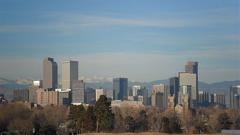

The City and County of Denver ( /ËndÉonvÉor/; Arapaho: NiineniiniicRihehe') is the largest city and the capital of the U.S. state of Colorado. Denver is also the second most populous county in Colorado after El Paso County. Denver is a consolidated city and county located in the South Platte River Valley on the western edge of the High Plains just east of the Front Range of the Rocky Mountains. The Denver downtown district is located immediately east of the confluence of Cherry Creek with the South Platte River, approximately 12 miles (19 km) east of the foothills of the Rocky Mountains. Denver is nicknamed the Mile-High City because its official elevation is exactly one mile or 5,280 feet (1,609.344 m) above sea level, making it one of the highest major cities in the United States. The 105th meridian west of Greenwich passes through Union Station and is the temporal reference for the Mountain Time Zone.
/ËndÉonvÉor/; Arapaho: NiineniiniicRihehe') is the largest city and the capital of the U.S. state of Colorado. Denver is also the second most populous county in Colorado after El Paso County. Denver is a consolidated city and county located in the South Platte River Valley on the western edge of the High Plains just east of the Front Range of the Rocky Mountains. The Denver downtown district is located immediately east of the confluence of Cherry Creek with the South Platte River, approximately 12 miles (19 km) east of the foothills of the Rocky Mountains. Denver is nicknamed the Mile-High City because its official elevation is exactly one mile or 5,280 feet (1,609.344 m) above sea level, making it one of the highest major cities in the United States. The 105th meridian west of Greenwich passes through Union Station and is the temporal reference for the Mountain Time Zone.
The 2011 estimated population of Denver was 619,968 which ranks it as the 23rd most populous U.S. city. The 10-county Denver-Aurora-Broomfield, CO Metropolitan Statistical Area had an estimated 2011 population of 2,599,504 and ranked as the 21st most populous U.S. metropolitan statistical area. The 12-county Denver-Aurora-Boulder Combined Statistical Area had an estimated 2011 population of 3,157,520 and ranked as the 16th most populous U.S. primary census statistical area. Denver is the center and the most populous city of the Front Range Urban Corridor, an oblong urban region stretching across 18 counties in two states with an estimated 2011 population of 4,423,936. Denver is the most populous city within a 500-mile (800 km) radius and the second most populous city in the Mountain West and the Southwestern United States after Phoenix, Arizona.
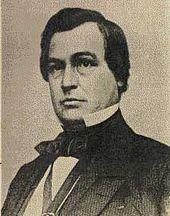
Denver City was founded in November 1858 as a mining town during the Pikes Peak Gold Rush in western Kansas Territory. That summer, a group of gold prospectors from Lawrence, Kansas, arrived and established Montana City on the banks of the South Platte River. This was the first settlement in what was later to become the city of Denver. The site faded quickly, however, and by the summer of 1859 it was abandoned in favor of Auraria (named after the gold mining town of Auraria, Georgia), and St. Charles City.
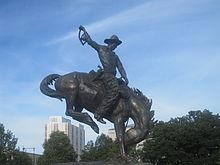
On November 22, 1858, General William Larimer, a land speculator from eastern Kansas, placed cottonwood logs to stake a claim on the bluff overlooking the confluence of the South Platte River and Cherry Creek, across the creek from the existing mining settlement of Auraria, and on the site of the existing townsite of St. Charles. Larimer named the town site Denver City to curry favor with Kansas Territorial Governor James W. Denver. Larimer hoped that the town's name would help make it the county seat of Arapaho County, but unknown to him Governor Denver had already resigned from office. The location was accessible to existing trails and was across the South Platte River from the site of seasonal encampments of the Cheyenne and Arapaho. The site of these first towns is now the site of Confluence Park in downtown Denver. Larimer, along with associates in the St. Charles City Land Company, sold parcels in the town to merchants and miners, with the intention of creating a major city that would cater to new emigrants. Denver City was a frontier town, with an economy based on servicing local miners with gambling, saloons, livestock and goods trading. In the early years, land parcels were often traded for grubstakes or gambled away by miners in Auraria. In May 1859, Denver City residents donated 53 lots to the Leavenworth & Pike aos Peak Express in order to secure the region aos first overland wagon route. Offering daily service for aupassengers, mail, freight, and gold, au the Express reached Denver on a trail that trimmed westward travel time from twelve days to six. In 1863, Western Union furthered Denver aos dominance of the region by choosing the city for its regional terminus.
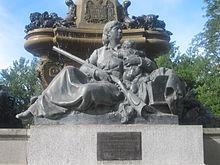
The Colorado Territory was created on February 28, 1861, Arapahoe County was formed on November 1, 1861, and Denver City was incorporated on November 7, 1861. Denver City served as the Arapahoe County Seat from 1861 until consolidation in 1902. In 1867, Denver City became the Territorial Capital. With its new-found importance, Denver City shortened its name to Denver. On August 1, 1876, Colorado was admitted to the Union.

Although by the close of the 1860s, Denver residents could look with pride at their success establishing a vibrant supply and service center, the decision to route the nation's first transcontinental railroad through Cheyenne, rather than Denver, threatened the prosperity of the young town. A daunting 100 miles away, citizen mobilized to build a railroad to connect Denver to the transcontinental railroad. Spearheaded by visionary leaders including Territorial Governor John Evans, David Moffat, and Walter Cheesman, fundraising began. Within three days, $300,000 had been raised, and citizens were optimistic. Fundraising stalled before enough was raised, forcing these visionary leaders to take control of the debt-ridden railroad. Despite challenges, on June 24, 1870, citizens cheered as the Denver Pacific completed the link to the transcontinental railroad, ushering in a new age of prosperity for Denver.
Finally linked to the rest of the nation by rail, Denver prospered as a service and supply center. The young city grew during these years, attracting millionaires with their mansions, as well as the poverty and crime of a rapidly-growing city. Denver citizens were proud when the rich chose Denver and were thrilled that Horace Tabor, the Leadville mining millionaire, built an impressive business block at 16th and Larimer as well as the elegant Tabor Grand Opera House. Luxurious hotels, including the much-loved Brown Palace Hotel, soon followed, as well as splendid homes for millionaires like the Croke, Patterson, Campbell Mansion at 11th and Pennsylvania and the now-demolished Moffat Mansion at 8th and Grant. Intent on transforming Denver into one of the world's great cities, leaders wooed industry and enticed laborers to work in these factories. Soon, in addition to the elite and a large middle class, Denver had a growing population of German, Italian, and Chinese laborers, soon followed by African-Americans and Spanish-surname workers. Unprepared for this influx, the Silver Crash of 1893 unsettled political, social, and economic balances, laying the foundation for ethnic bigotry, such as the Red Scare and the rise of the Ku Klux Klan, as well as corruption and crime.
Between 1880 and 1895 the city experienced a huge rise in corruption, as crime bosses, such as Soapy Smith, worked side by side with elected officials and the police to control elections, gambling, and the bunko gangs. The city also experienced a depression in 1893 after the crash of silver prices. In 1887, the precursor to the international charity United Way was formed in Denver by local religious leaders who raised funds and coordinated various charities to help Denver's poor. By 1890, Denver had grown to be the second-largest city west of Omaha, Nebraska, but by 1900 it had dropped to third place behind San Francisco and Los Angeles. In 1900, whites represented 96.8% of Denver's population.
In 1901, the Colorado General Assembly voted to split Arapahoe County into three parts: a new consolidated City and County of Denver, a new Adams County, and the remainder of the Arapahoe County to be renamed South Arapahoe County. A ruling by the Colorado Supreme Court, subsequent legislation, and a referendum delayed the creation of the City and County of Denver until November 15, 1902.
Denver has hosted the Democratic National Convention twice, during the years of 1908, and again in 2008, taking the opportunity to promote the city's status on the national, political, and socioeconomic stage.
Early in the 20th century, Denver, like many other cities, was home to a pioneering Brass Era car company. The Colburn Automobile Company made cars copied from the contemporary Renault.
From 1953 to 1989, the Rocky Flats Plant, a DOE nuclear weapon facility formerly located about 15 miles from Denver, produced fissile plutonium "pits" for nuclear warheads. A major fire at the facility in 1957, as well as leakage from nuclear waste stored at the site between 1958 and 1968, resulted in the contamination of some parts of Denver, to varying degrees, with plutonium-239, a harmful radioactive substance with a half-life of 24,200 years. A study by the Jefferson County health director, Dr. Carl Johnson, in 1981 linked the contamination to an increase in birth defects and cancer incidence in central Denver and nearer Rocky Flats. Later studies confirmed many of his findings. Plutonium contamination was still present outside the former plant site as of August 2010[update], and presents risks to building the envisioned Jefferson Parkway, which would complete Denver's automotive beltway.
Denver was selected in 1970 to host the 1976 Winter Olympics to coincide with Colorado's centennial celebration, but in November 1972 Colorado voters struck down ballot initiatives allocating public funds to pay for the high costs of the games, which were subsequently moved to Innsbruck, Austria. The notoriety of becoming the only city ever to decline to host an Olympiad after being selected has made subsequent bids difficult. The movement against hosting the games was based largely on environmental issues and was led by State Representative Richard Lamm, who was subsequently elected to three terms (1975 ae87) as Colorado governor. Denver explored a potential bid for the 2022 Winter Olympics, but no bid will be submitted. In 2010, Denver adopted a comprehensive update of its zoning code. The new zoning was developed to guide development as envisioned in adopted plans such as Blueprint Denver, Transit Oriented Development Strategic Plan, Greenprint Denver, and the Strategic Transportation Plan.
Denver has also been known historically as the Queen City of the Plains and the Queen City of the West, because of its important role in the agricultural industry of the high-plains region in eastern Colorado and along the foothills of the Colorado Front Range. Several US Navy ships have been named USS Denver in honor of the city.
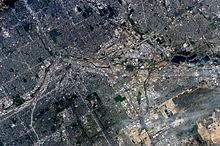
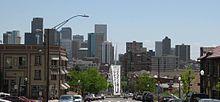
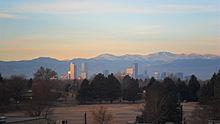
Denver is located in the center of the Front Range Urban Corridor, between the Rocky Mountains to the west and the High Plains to the east. Denver's topography consists of plains in the city center with hilly areas to the west, south, and southeast. According to the United States Census Bureau the city has an area of 154.9 square miles (401.2 km2), of which 1.6 square miles (4.1 km2), or 1.03%, is water. The City and County of Denver is surrounded by only three other counties: Adams County to the north and east, Arapahoe County to the south and east, and Jefferson County to the west.
Although Denver's nickname is the "Mile-High City" because its official elevation is one mile above sea level, defined by the elevation of the spot of a benchmark on the steps of the State Capitol building, the elevation of the entire city ranges from 5,130 to 5,690 feet. According to Geographic Names Information System (GNIS) and the National Elevation Dataset, the city's elevation is 5,278 feet, which is reflected on various websites such as that of the National Weather Service.
Denver lies within the semi-arid, continental climate zone (Koppen climate classification BSk). It has four distinct seasons and receives a modest amount of precipitation spread through the year. Due to its inland location on the High Plains, at the foot of the Rocky Mountains, Denver, like all cities along the eastern edge of the Rocky Mountains, is subject to sudden changes in weather. Denver aos climate is very sunny, averaging 3,106 hours or 300 days of sunshine a year. July is the warmest month of the year, with high temperatures averaging almost 90 °F (32 °C) and lows averaging around 60 °F (16 °C) resulting in a mean monthly temperature of 74.2 °F (23.4 °C), according to the most recent monthly data compiled by the National Weather Service out of Denver. Summers range from mild to hot with occasional afternoon thunderstorms. December, the coldest month of the year, has an average high temperature of 44 °F (7 °C) and an average low temperature of 18 °F ( na8 °C), resulting in an average monthly temperature of 30.7 °F ( na0.7 °C). Winters range from cool to cold, with periods of snow and very low temperatures alternating with periods of milder weather, the result of chinook winds. Days above 60 °F (16 °C) occur occasionally during winter, and alternate with cold snaps, the result of which produce nightly temperatures below 0 °F ( na18 °C) on 6.8 days per year. Snowfall is common throughout the late fall, winter, and spring, averaging 61.8 inches (157 cm) a season during the 1971 na2000 period, but falling to 53 inches (130 cm) for 1981 na2010. The average first frost in Denver is October 4, and the average last frost is May 10, allowing a growing season of around 150 days. The lowest temperature ever recorded in Denver was recorded on January 9, 1875 at na29 °F ( na34 °C). The highest temperature ever recorded in Denver is 105 °F (41 °C) (National Weather Service) on August 8, 1878, July 20, 2005, June 25, 2012 and June 26, 2012.
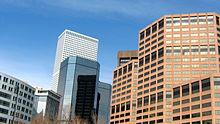
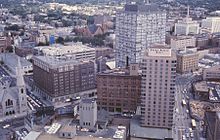
The City and County of Denver has defined 80 official neighborhoods that the city and community groups use for planning and administration. Although the city's delineation of the neighborhood boundaries is somewhat arbitrary, it corresponds roughly to the definitions used by residents. These "neighborhoods" should not be confused with cities or suburbs, which may be separate entities within the metro area.
The character of the neighborhoods vary significantly from each other and include everything from large skyscrapers to turn of the twentieth century houses to modern, suburban style developments. Generally, the neighborhoods closest to the city center are denser, older and contain more brick building material. Many neighborhoods away from the city center were developed after World War II, and are built with more modern materials and style. Some of the neighborhoods even farther from the city center, or recently redeveloped parcels anywhere in the city have either very suburban characteristics or are new urbanist developments that attempt to recreate the feel of older neighborhoods. Most neighborhoods contain parks or other features that are the focal point for the neighborhood.
Denver does not have larger area designations, unlike the City of Chicago which has larger areas that house the neighborhoods (IE: Northwest Side). Denver residents use the terms "north" "south" "east" and "west" loosely.
Denver also has a number of neighborhoods not reflected in the administrative boundaries. Sometimes, these neighborhoods reflect the way people in an area identify themselves; sometimes, they reflect how others, such as real estate developers, have defined those areas.
Well-known neighborhoods include the historic and trendy LoDo (short for "Lower Downtown"), part of the city's Union Station neighborhood; Capitol Hill, Baker, South City Park/Greektown, Highland, Cherry Creek, Washington Park, Lowry; Uptown; Curtis Park, part of the Five Points neighborhood; Alamo Placita, the northern part of the Speer neighborhood; Park Hill, a successful example of intentional racial integration; and Golden Triangle, in the Civic Center.
As of 2006, Denver had over 200 parks, from small mini-parks all over the city to the giant 314 acres (1.27 km2) City Park. Denver also has 29 recreation centers providing places and programming for resident's recreation and relaxation.
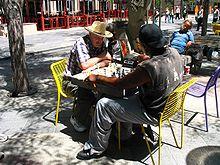
Many of Denver's parks were acquired from state lands in the late 19th and early 20th centuries. This coincided with the City Beautiful movement, and Denver mayor Robert Speer (1904 ae12 and 1916 ae18) set out to expand and beautify the city's parks. Reinhard Schuetze was the city's first landscape architect, and he brought his German-educated landscaping genius to Washington Park, Cheesman Park, and City Park among others. Speer used Schuetze as well as other landscape architects such as Frederick Law Olmsted, Jr. and Saco Rienk DeBoer to design not only parks such as Civic Center Park, but many city parkways and tree-lawns. All of this greenery was fed with South Platte River water diverted through the city ditch.
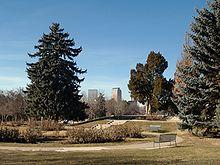
In addition to the parks within Denver itself, the city acquired land for mountain parks starting in the 1911s. Over the years, Denver has acquired, built and maintained approximately 14,000 acres (57 km2) of mountain parks, including Red Rocks Park, which is known for its scenery and musical history revolving around the unique Red Rocks Amphitheatre. Denver also owns the mountain on which the Winter Park Resort ski area is operated in Grand County, 67 miles (110 km) west of Denver. City parks are important places for both Denverites and visitors, inciting controversy with every change. Denver continues to grow its park system with the development of many new parks along the Platte River through the city, and with Central Park and Bluff Lake Nature Center in the Stapleton neighborhood redevelopment. All of these parks are important gathering places for residents and allow what was once a dry plain to be lush, active, and green. Denver is also home to a large network of public community gardens, most of which are managed by Denver Urban Gardens, a non-profit organization.
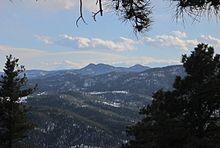
Since 1974, Denver and the surrounding jurisdictions have rehabilitated the urban South Platte River and its tributaries for recreational use by hikers and cyclists. The main stem of the South Platte River Greenway runs along the South Platte from Chatfield Reservoir 35 miles (56 km) into Adams County in the north. The Greenway project is recognized as one of the best urban reclamation projects in the U.S., winning, for example, the Silver Medal Rudy Bruner Award for Urban Excellence in 2001.
The United States Census Bureau estimated that, in 2008, the population of the City and County of Denver was 600,158, making it the 24th most populous U.S. city. The Denver-Aurora-Broomfield, CO Metropolitan Statistical Area had an estimated 2008 population of 2,506,626 and ranked as the 21st most populous U.S. metropolitan statistical area, and the larger Denver-Aurora-Boulder Combined Statistical Area had an estimated 2008 population of 3,049,562 and ranked as the 16th most populous U.S. metropolitan area. Denver is the most populous city within a radius centered in the city and of 550 miles (885 km) magnitude. Denverites is a term used for residents of Denver.
According to census estimates, the City and County of Denver contains approximately 566,974 people (2006) and 239,235 households (2000). The population density is 3,698 inhabitants per square mile (1,428/km ²) including the airport. There are 268,540 housing units (2005) at an average density of 1,751 per square mile (676/km ²). However, the average density throughout most Denver neighborhoods tends to be higher. Without the 80249 zip code (47.3 sq mi, 8,407 residents) near the airport, the average density increases to around 5,470 per square mile.
According to the 2010 United States Census, the racial composition of Denver was as follows:
Source:
Approximately 70.3% of the population (over five years old) spoke only English at home. An additional 23.5% of the population spoke Spanish at home. In terms of ancestry, 31.2% were Mexican, 14.6% of the population were of German ancestry, 9.7% were of Irish ancestry, 8.9% were of English ancestry, and 4.0% were of Italian ancestry.
There are 250,906 households, of which 23.2% have children under the age of 18 living with them, 34.7% are married couples living together, 10.8% have a female householder with no husband present, and 50.1% are non-families. 39.3% of all households are made up of individuals and 9.4% have someone living alone who is 65 years of age or older. The average household size is 2.27 and the average family size is 3.14.
Age distribution is 22.0% under the age of 18, 10.7% from 18 to 24, 36.1% from 25 to 44, 20.0% from 45 to 64, and 11.3% who are 65 years of age or older. The median age is 33 years. For every 100 females there are 102.1 males.
The median household income is $45,438, and the median family income is $48,195. Males have a median income of $36,232 versus $33,768 for females. The per capita income for the city is $24,101. 19.1% of the population and 14.6% of families are below the poverty line. Out of the total population, 25.3% of those under the age of 18 and 13.7% of those 65 and older are living below the poverty line.

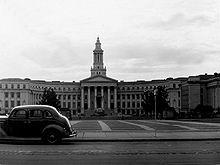
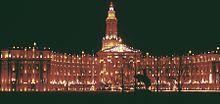
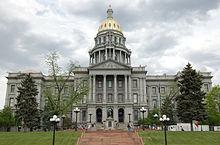
Denver is a consolidated city-county with a mayor elected on a nonpartisan ballot, a 13-member city council and an auditor. The Denver City Council is elected from 11 districts with two at-large council-members and is responsible for passing and changing all laws, resolutions, and ordinances, usually after a public hearing. They can also call for misconduct investigations of Denver's departmental officials.
Denver has a strong mayor/weak city council government. The mayor can approve or veto any ordinances or resolutions approved by the council, makes sure all contracts with the city are kept and performed, signs all bonds and contracts, is responsible for the city budget, and can appoint people to various city departments, organizations, and commissions. However, the council can override the mayor's veto with a nine out of thirteen member vote, and the city budget must be approved and can be changed by a simple majority vote of the council. The auditor checks all expenditures and may refuse to allow specific ones, usually based on financial reasons.
All elected officials have four-year terms, with a maximum of three terms. While Denver elections are non-partisan, Democrats have long held a majority sway on Denver politics with most officials elected citywide having Democratic Party affiliation. In federal elections, Denverites also tend to vote for Democratic candidates, voting for the Democratic Presidential nominee in every election since 1960 (excluding 1980 and 1972). The office of Denver's Mayor has been occupied by a Democrat since the municipal general election of 1963, including the current mayor, Michael Hancock. Denver is represented at the federal level by congresswoman Diana DeGette, a Democrat representing Colorado's 1st congressional district, which includes all of Denver and parts of Arapahoe County.
Benjamin F. Stapleton was the mayor of Denver, Colorado for two periods, the first from 1923 to 1931 and the second from 1935 to 1947. Stapleton was responsible for many civic improvements during his term, notably during his second stint as mayor when he had access to funds and manpower from the New Deal. During this time, the park system was considerably expanded and the Civic Center completed. His signature project was the construction of Denver Municipal Airport, which began in 1929 amidst heavy criticism. It was later renamed Stapleton International Airport in his honor. Today, the airport no longer stands, but has been replaced by a neighborhood also named Stapleton. Stapleton Street continues to bear his name.
During the 1960s and 1970s, Denver was one of the epicenters of the Chicano Movement. The boxer-turned-activist Rodolfo "Corky" Gonzales formed an organization called the Crusade for Justice, which battled police brutality, fought for bilingual education, and, most notably, hosted the First National Chicano Youth Liberation Conference in March 1969.
In recent years, Denver has taken a stance on helping people who are or become homeless, particularly under the administrations of mayors John Hickenlooper and Wellington Webb. Denver's homeless population is considerably lower than many other major cities, but residents of the city streets have suffered during Denver's winters. Although mild and dry much of the time, Denver's winters can have brief periods of cold temperatures and varying amounts of snow.
In 2005, Denver became the first major city in the U.S. to make the private possession of less than an ounce of marijuana legal for adults 21 and older. The city voted 53.49 ae46.51 percent in favor of the marijuana legalization measure. This initiative does not usurp state law, which currently treats marijuana possession in much the same way as a speeding ticket with fines of up to $100 and no jail time. The electorate of Colorado voted on and rejected a similar statewide initiative in November 2006. Denver passed an initiative in the fourth quarter of 2007 requiring the mayor to appoint an 11 member review panel to monitor the city's compliance with the 2005 ordinance. Former Denver mayor John Hickenlooper was a member of the Mayors Against Illegal Guns Coalition, an organization formed in 2006 and co-chaired by New York City mayor Michael Bloomberg and Boston mayor Thomas Menino.
Denver hosted the 2008 Democratic National Convention, which was the centennial of the city's first hosting of the landmark 1908 convention. It also hosted the G7 (now G8) summit between June 20 and June 22 in 1997 and the 2000 National Convention of the Green Party.
On October 31, 2011 it was announced that The University of Denver in Denver was selected as the host of the first of three 2012 presidential debates to be held on October 3, 2012.
The City and County of Denver levies an Occupational Privilege Tax (OPT or Head Tax) on employers and employees.
The city of Denver is protected 24/7, 365 by the paid, full-time firefighters of the city of Denver Fire Department(DFD). The Denver Fire Department currently is organized into 6 Division of Operations, each under the Command of a Division Chief: Operations Division; Fire Prevention and Investigation Division; Technical Services Division; Administrative Division; Safety and Training Division; Airport Division.
The DFD currently operates out of 34 Fire Stations(including 4 Airport Stations) in 6 Districts, each under the command of an Assistant Chief, located throughout the city. The Denver Fire Department also operates a fire apparatus fleet of 28 Engines, 14 Trucks, 1 Heavy Rescue, 1 Haz-Mat. Unit, 1 Collapse Unit, 1 Water Rescue Unit, and numerous other special, support, and reserve units. The current Chief of Department is Eric Tade.
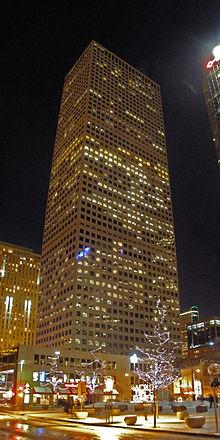
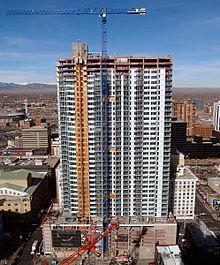
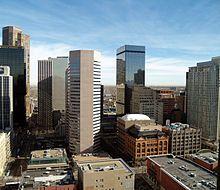
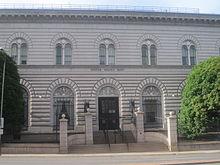
The Denver MSA has a gross metropolitan product of $157.6 billion in 2010, making it the 18th largest metro economy in the United States. Denver's economy is based partially on its geographic position and its connection to some of the major transportation systems of the country. Because Denver is the largest city within 500 miles (800 km), it has become a natural location for storage and distribution of goods and services to the Mountain States, Southwest states, as well as all western states. Another benefit for distribution is that Denver is nearly equidistant from large cities of the Midwest such as, Chicago and St. Louis and some large cities of the West Coast such as, Los Angeles and San Diego. Over the years, the city has been home to other large corporations in the central United States, making Denver a key trade point for the country. Several well-known companies originated in or have relocated to Denver. William Ainsworth opened the Denver Instrument Company in 1895 to make analytical balances for gold assayers. Its factory is now in Arvada. AIMCO (NYSE: AIV) the largest owner and operator of apartment communities in the United States, with approximately 870 communities comprising nearly 136,000 units in 44 states, is headquartered in Denver, employing approximately 3,500 people. Also Samsonite Corp., the world's largest luggage manufacturer, began in Denver in 1910 as Shwayder Trunk Manufacturing Company but Samsonite closed its NE Denver factory in 2001, and moved its headquarters to Massachusetts after a change of ownership in 2006. The Mountain States Telephone & Telegraph Company, founded in Denver in 1911, is now a part of telecommunications giant CenturyLink. MediaNews Group purchased the Denver Post in 1987; the company is based in Denver. The Gates Corporation, the world's largest producer of automotive belts and hoses, was established in S. Denver in 1919. Russell Stover Candies Inc. made its first chocolate candy in Denver in 1923, but moved to Kansas City in 1969. The Wright & McGill Company has been making its Eagle Claw brand of fishing gear in NE Denver since 1925. The original Frontier Airlines began operations at Denver's old Stapleton International Airport in 1950. Frontier was reincarnated at DIA in 1994. Scott's Liquid Gold, Inc., has been making furniture polish in Denver since 1954. Village Inn restaurants began as a single pancake house in Denver in 1958. Big O Tires, LLC, of Centennial opened its first franchise in 1962 in Denver. The Shane Company sold its first diamond jewelry in 1971 in Denver. Johns Manville Corp., a manufacturer of insulation and roofing products, relocated its headquarters to Denver from New York in 1972. CH2M HILL Inc., an engineering and construction firm, relocated from Oregon to the Denver Technological Center in 1980. The Ball Corporation sold its glass business in Indiana in the 1990s and moved to suburban Broomfield. Ball has several operations in greater Denver. Molson Coors Brewing Company established its U.S. headquarters in Denver in 2005. Its subsidiary and regional wholesale distributor, Coors Distributing Company, is in NW Denver. The Newmont Mining Corporation, the 2nd largest gold producer in North America and one of the largest in the world, is headquartered in Denver. Large Denver-area employers that have headquarters elsewhere include Lockheed Martin Corp., United Airlines, Kroger Co. and Xcel Energy, Inc. MapQuest, an online site for maps, directions and business listings, is headquartered in Denver's LODO district. Online Trading Academy, a professional trader education company, has an office and center that is operating in Denver.
Geography also allows Denver to have a considerable government presence, with many federal agencies based or having offices in the Denver area. Along with federal agencies come many companies based on US defense and space projects, and more jobs are brought to the city by virtue of its being the capital of the state of Colorado. The Denver area is home to the former nuclear weapons plant Rocky Flats, the Denver Federal Center, the Denver Mint and the National Renewable Energy Laboratory.
In 2005, a $310.7 million expansion for the Colorado Convention Center was completed, doubling its size. The hope was that the center's expansion would elevate the city to one of the top 10 cities in the nation for holding a convention.
Denver's position near the mineral-rich Rocky Mountains encouraged mining and energy companies to spring up in the area. In the early days of the city, gold and silver booms and busts played a large role in the economic success of the city. In the 1970s and early 1980s, the energy crisis in America and resulting high oil prices created an energy boom in Denver captured in the soap opera Dynasty. Denver was built up considerably during this time with the construction of many new downtown skyscrapers. When the price of oil dropped from $34 a barrel in 1981 to $9 a barrel in 1986 the Denver economy dropped with it, leaving almost 15,000 oil industry workers in the area unemployed (including former mayor and current governor John Hickenlooper, a former geologist), and the highest office vacancy rate in the nation (30%). There remain 700 employed petroleum engineers in the region, and energy and mining are still important in Denver's economy today, with companies such as EnCana, Halliburton, Smith International, Rio Tinto Group, Newmont Mining, Noble Energy, and Anadarko.
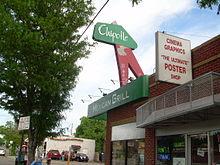
Denver's west-central geographic location in the Mountain Time Zone (UTC na7) also benefits the telecommunications industry by allowing communication with both North American coasts, South America, Europe, and Asia in the same business day. Denver's location on the 105th meridian at over one mile (1.6 km) in elevation also enables it to be the largest city in the U.S. to offer a 'one-bounce' real-time satellite uplink to six continents in the same business day. Qwest Communications, Dish Network Corporation, Starz-Encore, DIRECTV, and Comcast are a few of the many telecommunications companies with operations in the Denver area. These and other high-tech companies had a boom in Denver in the mid to late 1990s. Denver had one of the lowest unemployment rates in the nation at 3.8% in October 2007. The Downtown region has seen increased real estate investment with the construction of several new skyscrapers set to be completed in 2010 ae2013. Online Trading Academy, a professional trader education company, has an office and center that is operating in Denver.
Denver has also enjoyed success as a pioneer in the fast casual restaurant industry, with many popular national chain restaurants founded and based in Denver. Chipotle Mexican Grill, Quizno's, and Smashburger were founded and headquartered in Denver. Qdoba Mexican Grill, Noodles & Company, and Good Times Burgers & Frozen Custard originated in Denver, but have moved their headquarters to the nearby suburbs of Wheat Ridge, Broomfield, and Golden.
The Denver Metropolitan Area is served by a variety of media outlets in print, radio, television, and the Internet.
Denver is the 16th-largest market in the country for television, according to the 2009 ae2010 rankings from Nielsen Media Research.
Denver is also served by over 40 AM and FM radio stations, covering a wide variety of formats and styles. Denver-Boulder radio is the No. 19 market in the United States, according to the Spring 2011 Arbitron ranking (up from No. 20 in Fall 2009). For a list of radio stations, see Radio Stations in Colorado
After a continued rivalry between Denver's two main newspapers, the Denver Post and Rocky Mountain News, the papers merged operations in 2001 under a Joint Operating Agreement which formed the Denver Newspaper Agency until February 2009 when E. W. Scripps Company, the owner of the Rocky Mountain News closed the paper. There are also several alternative or localized newspapers published in Denver, including the Westword, The Onion and Out Front Colorado. Denver is home to multiple regional magazines such as 5280, which takes its name from the city's 5280 feet (1609 m) high elevation.

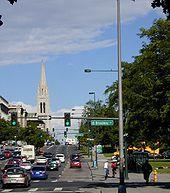
Most of Denver has a straightforward street grid oriented to the four cardinal directions. Blocks are usually identified in hundreds from the median streets, identified as "00", which are Broadway (the east aewest median, running north aesouth) and Ellsworth Avenue (the north aesouth median, running east aewest). Colfax Avenue, the major east aewest artery through Denver, is 15 blocks (1500) north of the median. Avenues north of Ellsworth are numbered (with the exception of Colfax Avenue and several others, such as Martin Luther King, Jr. Blvd and Montview Blvd.), while avenues south of Ellsworth are named.
There is also an older downtown grid system that was designed to be parallel to the confluence of the South Platte River and Cherry Creek. Most of the streets downtown and in LoDo run northeast aesouthwest and northwest aesoutheast. This system has an unplanned benefit for snow removal; if the streets were in a normal N aeS/E aeW grid, only the N aeS streets would receive sunlight. With the grid oriented to the diagonal directions, the NW aeSE streets receive sunlight to melt snow in the morning and the NE aeSW streets receive it in the afternoon. This idea was from Henry Brown the founder of the Brown Palace Hotel. There is now a plaque across the street from the Brown Palace Hotel which honors this idea. The NW aeSE streets are numbered, while the NE aeSW streets are named. The named streets start at the intersection of Colfax Avenue and Broadway with the block-long Cheyenne Place. The numbered streets start underneath the Colfax and I-25 viaducts. There are 27 named and 44 numbered streets on this grid. There are also a few vestiges of the old grid system in the normal grid, such as Park Avenue, Morrison Road, and Speer Boulevard. Larimer Street, named after William Larimer, Jr., the founder of Denver, which is located in the heart of LoDo, is the oldest street in Denver.
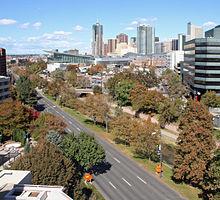
All roads in the downtown grid system are streets. (16th Street, Stout Street) Roads outside that system that travel east/west are given the suffix "avenue" and those that head north and south are given the "street" suffix. (Example, Colfax Avenue, Lincoln Street,). Boulevards are higher capacity streets and travel any direction (more commonly north and south). Smaller roads are sometimes referred to as places, drives (though not all drives are smaller capacity roads, some are major thoroughfares) or courts. Most streets outside the area between Broadway and Colorado Boulevard are organized alphabetically from the city's center.
Many Denver streets have bicycle lanes, and there are over 850 miles of paved, off-road, bike paths in Denver parks and along bodies of water, like Cherry Creek and the South Platte. This allows for a significant portion of Denver's population to be bicycle commuters and has led to Denver being known as a bicycle friendly city. In addition to the many bike paths, Denver launched B-Cycle ae a city-wide bicycle sharing program ae in late April 2010. The B-Cycle network was the largest in the United States at the time of its launch, boasting 400 bicycles.
The Denver Boot, a car-disabling device was first used in Denver.
A 2011 study by Walk Score ranked Denver sixteenth most walkable of fifty largest U.S. cities.
Denver is primarily served by the interstate freeways I-25 and I-70. The intersection of the two interstates is referred to locally as "the mousetrap", because when viewed from the air, the junction (and subsequent vehicles) resemble mice in a large trap.
Denver also has a nearly complete beltway known as "the 470's". These are SH 470 (also known as C-470), a freeway in the southwest Metro area, and two toll highways, E-470 (from southeast to northeast) and Northwest Parkway (from terminus of E-470 to US-36). SH 470 was originally intended to be I-470 and built with federal highway funds, but the funding was redirected to complete conversion of downtown Denver's 16th Street to a pedestrian mall. As a result, construction was delayed until 1980 after state and local legislation was passed. I-470 was also once called "The Silver Stake Highway", from Gov. Lamm's declared intention to drive a silver stake through it and kill it.
A highway expansion and transit project for the southern I-25 corridor, dubbed T-REX (Transportation Expansion Project), was completed on November 17, 2006. The project installed wider and additional highway lanes, and improved highway access and drainage. The project also includes a light rail line that traverses from downtown to the south end of the metro area at Lincoln Avenue. The project spanned almost 19 miles (31 km) along the highway with an additional line traveling parallel to part of I-225, stopping just short of Parker Road.
Metro Denver highway conditions can be accessed on the Colorado Department of Transportation website Traffic Conditions.
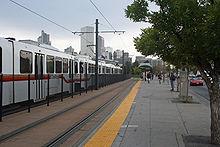
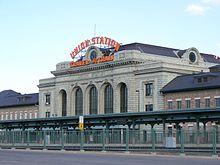
Mass transportation throughout the Denver metropolitan area is managed and coordinated by the Regional Transportation District (RTD). RTD currently operates more than 1,000 buses serving over 10,000 bus stops in 38 municipal jurisdictions in eight counties around the Denver and Boulder metropolitan areas. Additionally, RTD operates five light rail lines, the C, D, E, F, and H with a total of 34.9 miles (56 km) of track, serving 36 stations. FasTracks is a light rail/bus/rail expansion project approved by voters in 2004 which will serve neighboring suburbs and communities.
Amtrak, the national passenger rail system, provides service to Denver, operating its California Zephyr daily in both directions between Chicago and Emeryville, California, across the bay from San Francisco. Amtrak Thruway service operated by private bus companies links the Denver station with Rocky Mountain points.
At Albuquerque, New Mexico, Denver Thruway connections are made daily with the Amtrak Southwest Chief. Additionally, the Ski Train operated on the former Denver & Rio Grande Western Railroad, which took passengers between Denver and the Winter Park Ski Resort, but it is no longer in service. The Ski Train made its final run to Winter Park on March 29, 2009.
Denver's early years as a major train hub of the west are still very visible today. Trains stop in Denver at historic Union Station, where travelers can access RTD's 16th Street Free MallRide or use light rail to tour the city. Union Station will also serve as the main juncture for rail travel in the metro area, at the completion of FasTracks.
Visitors to Union Station can also experience Railroading in the Rockies from the 1950s by checking out the model railroad clubs in the basement. The Denver Society of Model Railroaders opens its display on the last Friday of the month except during the summer. The Platte Valley & Western Model Railroad Club is open every Friday night year round and offers visitors a chance to view how Denver looked during the 1950s. The club also offers behind the scenes tours as well as educational events and information to visitors.
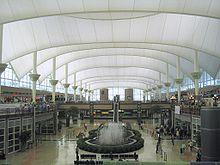
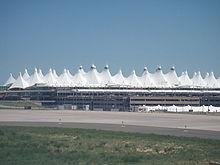
Denver International Airport (IATA: DEN, ICAO: KDEN), commonly known as DIA, serves as the primary airport for a large region surrounding Denver. DIA is located 18.6 miles (30 km) east-northeast of the Colorado State Capitol. DIA is the tenth busiest airport in the world and ranks fourth in the United States, with 51,245,334 passengers passing through it in 2008.[100] It covers more than 53 square miles (137.3 km2), making it the largest airport by land area in the United States and larger than the island of Manhattan.[101][102] Denver serves as a major hub for United Airlines, is the headquarters for Frontier Airlines, and is the fastest-growing focus city for Southwest Airlines.
Three general aviation airports serve the Denver area. Rocky Mountain Metropolitan Airport (KBJC) is 13.7 miles (22 km) north-northwest, Centennial Airport (KAPA) is 13.7 miles (22 km) south-southeast, and Front Range Airport (KFTG) is located 23.7 miles (38 km) east of the state capitol.
In the past, Denver has been home to several other airports that are no longer operational. Stapleton International Airport was closed in 1995 when it was replaced by DIA. Lowry Air Force Base was a military flight training facility that ceased flight operations in 1966, with the base finally being closed in 1994. It is currently being used for residential purposes. Buckley Air Force Base, a former Air National Guard base is currently the only military facility in the Denver-Metro area.
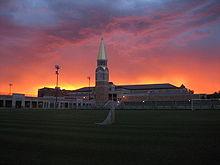
Denver Public Schools (DPS) is the public school system in Denver. It currently educates about 73,000 students in 73 elementary schools, 15 K-8 schools, 17 middle schools, 14 high schools, and 19 charter schools.[103] The first school of what is now DPS was a log cabin that opened in 1859 on the corner of 12th Street between Market and Larimer Streets. The district boundaries are coextensive with the city limits.
Denver's many colleges and universities range in age and study programs. The private University of Denver was the first institution of higher learning in the city and was founded in 1864. Other prominent Denver higher education institutions include Johnson & Wales University, Catholic (Jesuit) Regis University and the three public schools that constitute the Auraria Campus, University of Colorado Denver, Metropolitan State College of Denver, and Community College of Denver. The city has Roman Catholic and Jewish institutions, as well as a health sciences school. In addition to those schools within the city, there are a number of schools located throughout the surrounding metro area.
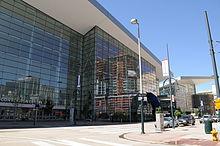
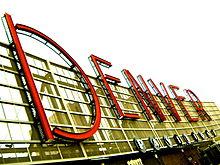
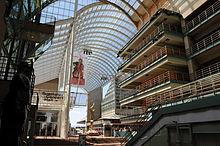
Apollo Hall opened quickly after the city's founding in 1859 and staged many plays for eager settlers. In the 1880s Horace Tabor built Denver's first Opera House. After the turn of the century, city leaders embarked on a city beautification program that created many of the city's parks, parkways, museums, and the Municipal Auditorium, which was home to the 1908 Democratic National Convention and is now known as the Ellie Caulkins Opera House. Denver and the metropolitan areas around it continued to support culture. In 1988, voters in the Denver Metropolitan Area approved the Scientific and Cultural Facilities Tax (commonly known as SCFD), a 1 cent sales tax that contributes money to various cultural and scientific facilities and organizations throughout the Metro area.[104] The tax was renewed by voters in 1994 and 2004 and allows the SCFD to operate until 2018.[105]
Denver is home to many nationally recognized museums, including a new wing for the Denver Art Museum by world-renowned architect Daniel Libeskind, the second largest Performing arts center in the nation after Lincoln Center in New York City and bustling neighborhoods such as LoDo, filled with art galleries, restaurants, bars and clubs. That is part of the reason why Denver was recently recognized for the third year in a row as the best city for singles.[106] Denver's neighborhoods also continue their influx of diverse people and businesses while the city's cultural institutions grow and prosper. The city acquired the estate of abstract expressionist painter Clyfford Still in 2004 and plans to build a museum to exhibit his works near the Denver Art Museum by 2010.[107] The Denver Museum of Nature and Science currently holds an aquamarine specimen valued at over one million dollars, as well as specimens of the state mineral, rhodochrosite. Every September the Colorado Convention Center at 451 E. 58th Avenue hosts a gem and mineral show.[108]
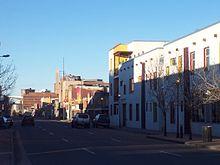
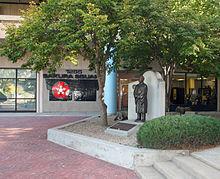
While Denver may not be as recognized for historical musical prominence as some other American cities, it still manages to have a very active pop, jazz, jam, folk, and classical music scene, which has nurtured several artists and genres to regional, national, and even international attention. Of particular note is Denver's importance in the folk scene of the 1960s and 1970s. Well-known folk artists such as Bob Dylan, Judy Collins and John Denver lived in Denver at various points during this time, and performed at local clubs.[109] Also, three members of the widely popular group Earth, Wind, and Fire are from Denver. More recent Denver-based artists include Air Dubai, The Fray, Flobots, Cephalic Carnage, Axe Murder Boyz, Deuce Mob, and Five Iron Frenzy.
Because of its proximity to the mountains, and generally sunny weather, Denver has gained a reputation as being a very active, outdoor oriented city. Many Denver residents spend the weekends in the mountains; either skiing in the winter or hiking, climbing, kayaking and camping in the summer.
Additionally, Denver and the surrounding cities of the Front Range are home to a large number of local and national breweries. Many restaurants in the region have on-site breweries, and some of the larger brewers, including Coors and the New Belgium Brewing Company, offer tours. Overall, Denver ranks 1st in the nation in terms of beer production per capita, and second overall in terms of number of breweries.[110] The city also welcomes visitors from around the world when it hosts the annual Great American Beer Festival each fall.
Denver used to be a major trading center for beef and livestock when ranchers would drive (or later transport) cattle to the Denver Union Stockyards for sale. As a celebration of that history, each year for more than a century, Denver hosts the National Western Stock Show, attracting as many as 10,000 animals and 700,000 attendees. The National Western Stock Show is held every January at the National Western Complex, northeast of downtown.
Denver hosts four large Mexican American celebrations: Cinco de Mayo (with over 500,000 attendees),[111] in May, El Grito de la Independencia, in September, the annual Lowrider show, and the Dia De Los Muertos art shows/events in North Denver's Highland neighborhood, and the Lincoln Park neighborhood in the original section of West Denver.
Denver is also famous for its dedication to New Mexican cuisine and the Chile. It's best known for its Green and Red Chile sauce, Colorado Burrito, Southwest (Denver) Omelette, Breakfast Burrito, Chiles rellenos, and Tamales most notably. Denver has a very large population of Mexican Americans (one of the country's largest), and is famous for many other southwest cuisine dishes as well. Denver is also well known for other types of food such as, Rocky Mountain oysters, Rainbow trout, and the Denver sandwich.
The Dragon Boat Festival in July, Moon Festival in September and Chinese New Year are annual events in Denver for the Chinese and Asian residents. Chinese hot pot (huo guo) and Korean BBQ restaurants have been growing in popularity. The Denver area has 2 Chinese newspapers, the Chinese American Post and the Colorado Chinese News.[112]
Denver is also the setting for The Bill Engvall Show, and the setting for the 18th season of MTV's The Real World. It was also the setting for the prime time drama Dynasty from 1981 to 1989 (although the show was mostly filmed in Los Angeles). From 1998 to 2002, the city's Alameda East Veterinary Hospital was home to the Animal Planet series Emergency Vets, which spun off three one-off documentary specials and the current Animal Planet series E-Vet Interns. The city is also the setting for the Disney Channel Original TV Show, Good Luck Charlie, which is currently in its third season.
Denver is home to a variety of sports teams and belongs to a select group of U.S. cities with teams from four major sports. Denver submitted the winning bid to host the 1976 Winter Olympics, but subsequently withdrew giving it the dubious distinction of being the only city to back out after winning a bid to host the Olympics. The Denver Broncos of the National Football League, who are currently coached by John Fox, have been able to draw crowds of nearly 70,000 since their American Football League origins in the early 1960s and continue to draw fans today to their current home Sports Authority Field at Mile High. The team has advanced to the Super Bowl six times and won back-to-back titles in 1998 and '99. The Broncos are owned by Pat Bowlen. In the 1980s and 1990s, one of the top priorities of former Mayor Federico PeR±a was bringing major league baseball to the city, an effort which culminated in the creation of the Colorado Rockies as an expansion franchise in 1993 and the opening of Coors Field in 1995. The Rockies advanced to the playoffs in 1995, but were eliminated in the first round. In 2007, their late-season winning streak saw them advance to the playoffs as a wild-card entrant, advance to and win the NL Championship Series and bring the World Series to Denver for the first time. Denver is also home to the Colorado Avalanche, a National Hockey League team that relocated from Quebec City in 1995. They have won two Stanley Cups (1996 and 2001) while in Denver and play at Pepsi Center, which also hosts the Denver Nuggets of the National Basketball Association, and the Colorado Mammoth of the National Lacrosse League. The Major League Soccer team Colorado Rapids play in Dick's Sporting Goods Park, an 18,000 seat stadium opened for the 2007 MLS season, located in Commerce City, a suburb of Denver.[113] and won the MLS Cup in 2010. In 2006 Denver established a professional outdoor lacrosse team, the Denver Outlaws. They play in Sports Authority Field at Mile High and are sanctioned by Major League Lacrosse. In 2006, The Denver Outlaws won the Western Conference Championship.
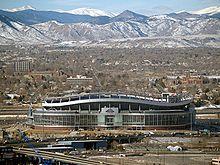
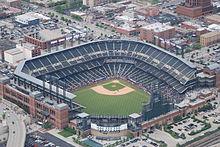
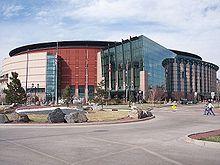
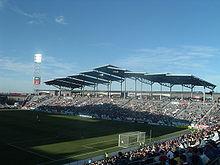
Denver's relationship with Brest, France, began in 1948, making it the second-oldest sister city in the United States.[114] Since then, Denver has established relationships with additional sister cities, and currently has a total of ten partnerships:[115]
In addition to these, the Denver Regional Council of Governments (consisting of the city and 51 other local governments) has established a "sister city" relationship with the Baghdad Governorate, one of Iraq's eighteen provinces.[116]

Word Count: 9268





